Confused about where to buy snowdrops? Do you want to buy rare or unusual snowdrops but are wondering how to go about this? I’m new to collecting and this article explains what I’ve learned about buying special and unusual snowdrops.
I started my small collection of 25 different snowdrops two years ago when I was introduced to a local collector and went to a snowdrop fair with him. He grew over 200 varieties in his small garden but some collectors have many hundreds or even thousands of bulbs. If you want to read about my visit to the snowdrop day and how it opened my eyes to the joy of snowdrop collection you can read my article on the Alpine Garden Society Website ‘Am I incubating galanthophilia?’
If you want to understand the huge variety of collector’s snowdrops out there you can read my article ‘A Flurry of Snowdrops’ which features some of my snowdrops. I describe how varied a flower the snowdrop can be and how some of the collector’s snowdrops differ from widely available ones.
Who collects snowdrops?
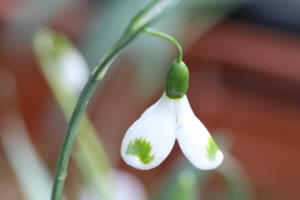
Galanthus ‘Trymmings’ a pagoda shaped flower with strong green markings on the outers. (Copyright Katharine Woods – Tea Break Gardener)
Snowdrop collectors are sometimes called Galanthophiles, after the latin name for snowdrop – Galanthus. My snowdrop friend preferred to call himself a ‘snowdropper’ and their collection ‘snowdroppery’. Whatever you choose to call them, snowdrop collectors are usually just gardeners with an eye for detail and a desire to have something to look forward to viewing in the long winter months. An obsessive desire to possess isn’t a necessary characteristic of snowdrop fans. Some snowdrop collectors just want some variety in their gardens in winter time.
Collector’s snowdrops are more unusual species and cultivars which vary from the standard ones in their shape, colouring or markings. There are thousands of different named cultivars, many particularly distinctive but others difficult to tell apart unless you are an enthusiast with good knowledge of the snowdrop and a keen eye for detail. Particularly popular at the moment are varieties with green or yellow markings.
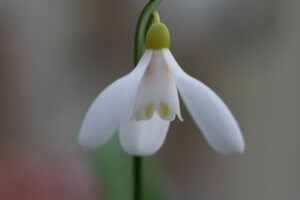
Galanthus worowonii Elizabeth Harrison a variety with bright green leaves and yellowy/olive markings and ovary. (Copyright Katharine Woods – Tea Break Gardener)
Some people, including many keen gardeners, scoff at the hobby of snowdrop collection. The sometimes eye-watering prices paid for a single bulb generate many column inches for the sceptics. Yet the prices equate to rarity – as they do with any plant. A plant with few bulbs in circulation will be more expensive than one with multiple sellers and plentiful supply. Prices start high when a new variety is introduced but soon drop as supply increases especially if the variety becomes popular and easy to grow.
How to buy snowdrops ‘in the green’ or as dormant bulbs
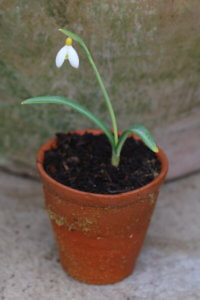
Copyright – Katharine Woods Tea Break Gardener
Collector’s snowdrops can be bought in winter and spring as actively growing plants, or in summer as dormant bulbs.
It is generally accepted that snowdrops are best planted ‘in the green’. This just means that the plants are still actively growing, with green leaves, stem and roots still attached to the bulb. Bulbs in the green will be growing in pots or will have been dug up from nursery beds and wrapped in moss, paper or bags for sale. Sometimes bulbs in the green will still have flowers, sometimes they will have finished flowering but collector’s snowdrops should always be bought in bud or flower so that the buyer can check they have the variety paid for.
Bulbs in the green are known to establish better in the garden than bulbs that have been left to go dormant, because the process of digging, cleaning, storing and distributing the bulbs allows them to dry out too much and snowdrop bulbs do not like to dry out. The exception to this is high quality dormant bulbs from specialist suppliers and I talk about this in more detail later.
Who sells collector’s snowdrops?
Retailers of special snowdrops fall into two categories in the UK.
- Bulb suppliers and nurseries – some are fairly large nurseries and others smaller outfits like a cottage industry
- Individual collectors with excess stock to swap or sell
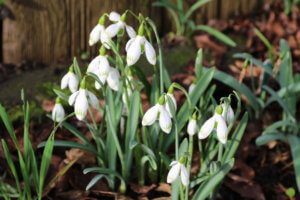
Galanthus ‘Sprite’ a pure white variety with parallel green stripes at the base of the outers. (Copyright Katharine Woods – Tea Break Gardener)
Snowdrop bulbs won’t always come true from seed, indeed the fact they cross pollinate so easily is the reason for the huge numbers of different cultivars available. Some unusual varieties have been found by chance in people’s gardens, others have been bred intentionally by specialist nurseries by crossing different species and cultivars.
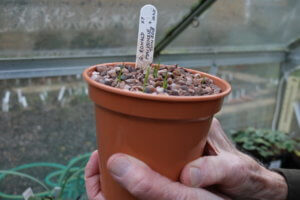
Shoots from one year old bulbils produced from twin scaling a larger bulb. These will take a year or two more to reach flowering size. Copyright – Katharine Woods, Tea Break Gardener
New bulbs for sale therefore need to be produced by what is known as vegetative propagation. The bulbs of an existing variety are harvested as they multiply in the ground or are chipped or twin scaled. The chipping process leads to the formation of tiny bulbils which are then grown on to flowering size – a process that will take 2-3 years. Bulbs that grow well in the garden and clump up easily can be dug and separated and sold on if a gardener feels they have some to spare.
The peak sales season for collector’s snowdrops is in winter and spring, when they are in flower – so that the buyer can be sure they have the right variety and that they are of flowering size.
Buying snowdrops at Plant Fairs and snowdrop days
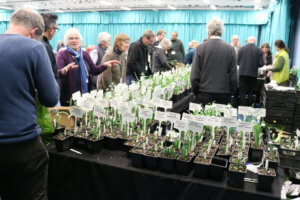 Alpine Garden Society Snowdrop Day 2019 (Copyright Katharine Woods – Tea Break Gardener)
Alpine Garden Society Snowdrop Day 2019 (Copyright Katharine Woods – Tea Break Gardener)
This is the best way to enjoy snowdrop buying and to get your collection going if you want to understand the variety of snowdrops out there. Seeing snowdrops in flower lined up on sales benches it is easy to spot the ones that appeal to you. You can also meet the grower, chat to them, ask for tips and add yourself to their mailing lists.
Snowdrop days are a highlight of the winter season and often take place in locations famed for snowdrop displays so that you can combine your visit with a snowdrop walk.
If you attend a snowdrop fair then it’s worth taking plenty of boxes to take your purchases home in. It’s also advisable to set yourself a budget as it’s tempting to splurge if the snowdrop bug bites.
Garden blogger Pumpkin Beth produces an annual list of snowdrop fairs so it’s worth checking her site before Christmas to plan your visits for the following year. Sadly, due to covid-19, many snowdrop fairs for 2021 have been cancelled but there’s a hope they will return again for 2022.
Buying snowdrops from Nursery catalogues and lists
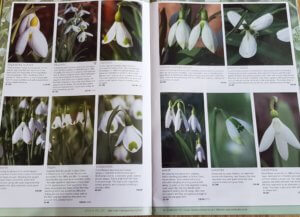
An extract from Avon Bulb’s snowdrop and summer bulb catalogue with great pictures and informative background on each plant.
Most specialist snowdrop sellers produce lists of items they grow and offer for sale each year. Avon Bulbs produces a beautiful catalogue which they will post to customers each January with named cultivars for sale and the same detail is available on their website. Some sell out quickly. North Green Snowdrops have a similarly informative and attractive brochure, only available online on their website.
Other nurseries produce paper lists or online lists and many have Facebook or other social media pages to alert buyers to their online sales, attendance at open days or the launch of their annual Ebay sales.
If you’re serious about starting a collection, do your research, contact the nurseries to be added to mailing lists or to receive catalogues, follow them on social media and get ready to check their websites frequently from January each year.
I have bought snowdrops from the following places in the past two years:
Pottertons Nursery – stockists of many alpines and bulbs, including snowdrops. Active on Twitter.
Avon Bulbs – stockists of many snowdrop cultivars both potted and dug in the green.
Monksilver Nursery – famed snowdrop breeder and nurseyman Joe Sharman. Sells predominantly at fairs and on Ebay. Website has list of their stocked snowdrops but no online sales. On Facebook.
Dryad Nursery – another famed snowdrop breeder, Ann Wright, also selling at fairs and on Ebay. Facebook page provides a useful prelude to what will be coming up for sale on Ebay.
Glen Chantry – Selling predominantly at fairs and snowdrop days but also have an excellent ‘Resting Snowdrop List’ of dormant bulbs each summer.
Matt Bishop Snowdrops – Snowdrop breeder and author. Sales from website and at plant fairs.
For more information on these and other sellers it’s worth taking a look at the website of Pumpkin Beth, a garden blogger. You can read her snowdrop nursery list here.
Buying snowdrops on Ebay
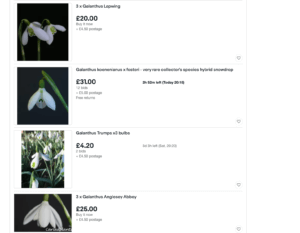
Many may be surprised to learn that Ebay is a major marketplace for collector’s snowdrops but it is now well established as a go to place to start or expand a collection. Sellers range from well known snowdrop breeding nurseries such as Monksilver Nursery and Dryad Nursery right through to home collectors with spare bulbs to sell. Many collectors will sell spare bulbs to raise money to invest in expanding their collection. Others spend time chipping bulbs to multiply their stocks.
When looking on Ebay for snowdrops it is best to search with the word ‘Galanthus’ as this is where you will find the rarer snowdrops. Most will be listed with the name of the cultivar, a photograph showing the flower and alongside a term such as ‘Rare Collectors Snowdrop’. Some are sold by auction and some are ‘Buy it now’. The more unusual varieties will tend to be auctioned as this is the best way for a seller to determine a market price.
The Ebay snowdrop sales season gets into swing from mid January. Items will be listed as they come into bud and flower, starting with the earlier varieties but varying considerably depending on where in the country a seller lives and how the plant is grown. If you’re new to Ebay it’s worth taking time to research the snowdrop auction items for a short while before bidding. Observe prices, research some of the sellers, and check their selling history and feedback. Check also for feedback on how well a seller packs the snowdrop for postage. The best sellers are used to wrapping the snowdrop plant in plastic, then paper and bubble wrap before posting in a cardboard tube.
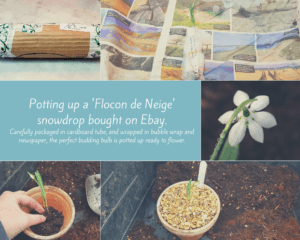
Ebay allows you to save your favourite sellers and to create a watch list of snowdrops you like the look of. Ebay will send reminders when the auction window is closing and you will be able to monitor how the sale price moves. Remember some of the snowdrops offered for sale are available through nursery catalogues too so for some items you can benchmark prices beforehand.
There is no shortage of buyers out there. I don’t buy often on Ebay but I have frequently been outbid in the very last seconds of a sale. For the rarely offered varieties it is worth having a maximum price in your head and bidding this in the closing seconds of a sale. If you’re outbid then you can reassure yourself you’d decided not to pay more.
The same variety will come up multiple times from multiple sellers so keep monitoring for new chances to bag the one you want. Remember also that prices of the rarer bulbs come down over the years if they’re garden-worthy and easy to grow. There’s always next year.
Buying summer dormant snowdrop bulbs
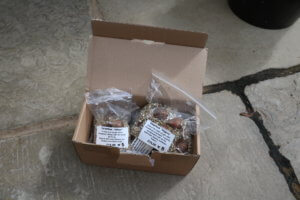
Dormant snowdrops – collectors’ varieties (Copyright Katharine Woods – Tea Break Gardener)
Buying in the green online, by Ebay or at a plants sale will reassure you that you have bought the correct variety and that the plant is healthy but there is another way to buy collector’s snowdrops – as dormant bulbs in the summer.
I would advise against buying dormant bulbs for standard snowdrops but if you buy collector’s ones from a reputable nursery you can guarantee you will be getting a fresh plump healthy bulb. Nurseries often check and repot their stocks in June and July and will produce lists of dormant collector’s bulbs at this time. I usually find these are slightly cheaper than when bought in the green. It is easier to post dormant bulbs too so this is a good way to grow a collection of named cultivars and pay less on postage and packing for several bulbs.
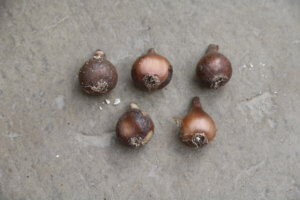
Healthy, plump, disease-free dormant snowdrop bulbs. Bought in summer from a specialist supplier to be potted up immediately. (Copyright Katharine Woods – Tea Break Gardener)
I was lucky to be gifted a starter collection from growers Rod and Jane Leeds two summers ago. I potted them up straight away and the following winter each one grew and flowered very well. I also bought dormant bulbs from Wol and Sue Staines at Glen Chantry nursery, all of which flowered beautifully too.
You will need to do some work and contact sellers to be added to their mailing lists well in advance of the summer. Rarer bulbs sell out quickly and many nurseries also limit purchases of the least commonly available bulbs to one per buyer.
I describe how I grow bulbs in pots in my article ‘How to grow snowdrops‘, including my chosen potting compost.
Good luck with your snowdrop collection and I hope they bring you as much joy every winter as mine do to me.
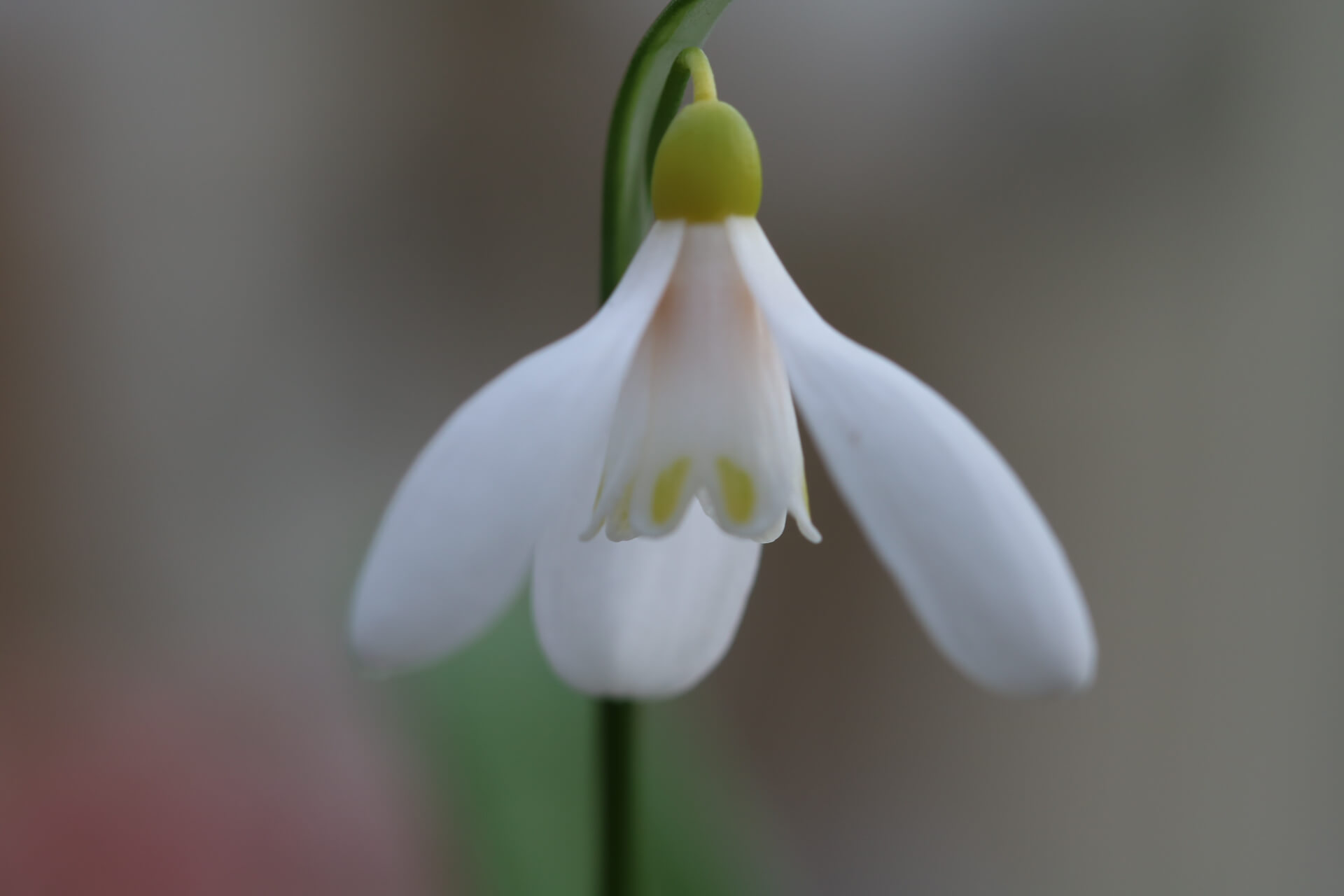
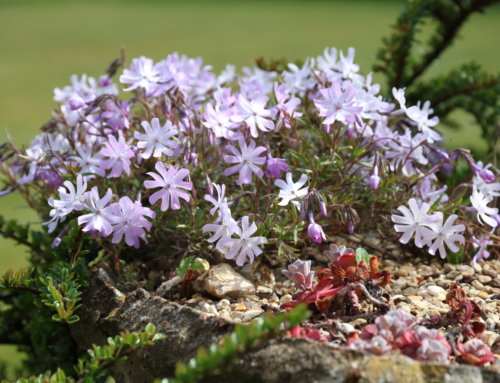
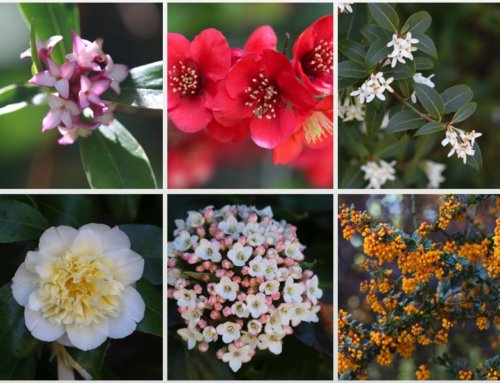
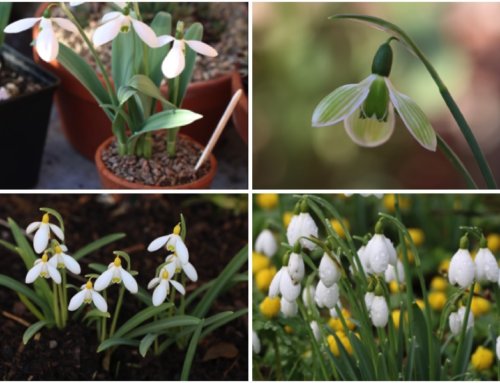
A great piece Katherine . I’m going to quote it in my new blog http://Www.chillderness.co.uk/blog . I’ve had a whole lot of heartache with this process all winter and am now fascinated by the idea of potting them up in summer…
Hi Anjana, Sorry to hear you’ve had heartache with it. Do you mean trying to buy some? Definitely worth repotting in summer. I’m keeping a few in pots but also slowly planting some out in the garden too. Good luck and ket me know how you get on.